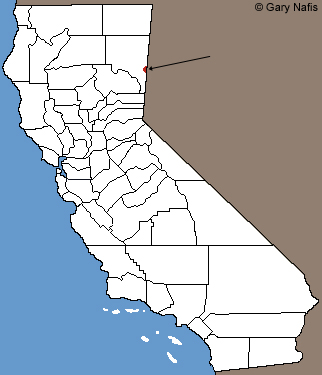|
| Possibly occurring in California - all pictures are of Nevada lizards |
 |
| Adult, Washoe County, Nevada |
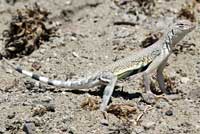 |
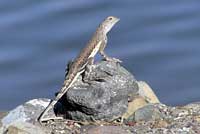 |
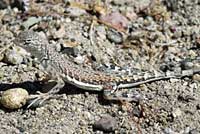 |
| Adult male, Washoe County, Nevada |
Adult female, Washoe County, Nevada |
Juvenile, Washoe County, Nevada |
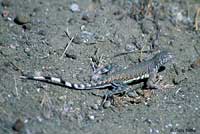 |
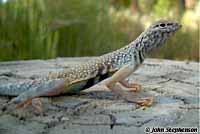 |
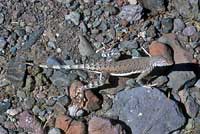 |
Adult, Washoe County, Nevada
|
Adult male, Douglas County, Nevada
© John Stephenson
|
Adult, Washoe County, Nevada |
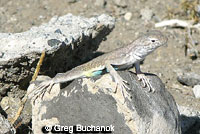 |
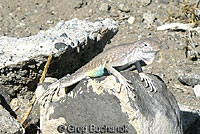 |
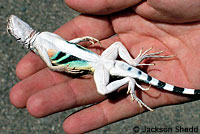 |
Adult male, in normal pose (left) changing to defensive pose (right)
Lyon County, Nevada © Greg Buchanok |
Adult male, Washoe County, Nevada
© Jackson Shedd |
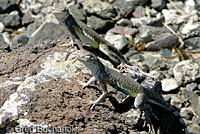 |
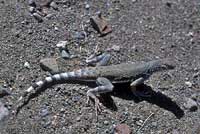 |
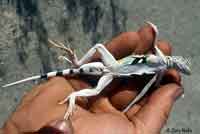 |
| Adult Female (in back) and Male, Lyon County, Nevada © Greg Buchanok |
Adult, Washoe County, Nevada
|
Adult male, Washoe County, Nevada
|
| |
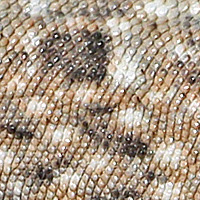 |
|
| |
Zebra-tailed Lizards, genus Callisaurus, have smooth granular scales above. |
|
| |
|
|
| California Habitat |
| |
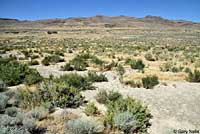 |
|
| |
Possible Habitat, Great Basin desert,
4,000 ft.,
Lassen County |
|
| |
|
|
| Habitat Outside California |
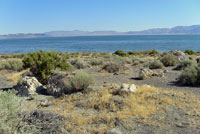 |
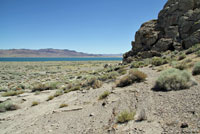 |
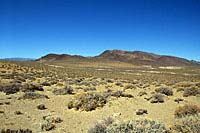 |
Habitat, Washoe County, Nevada
|
Habitat, Washoe County, Nevada |
Habitat, Washoe County, Nevada |
| Short Videos |
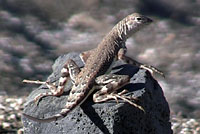 |
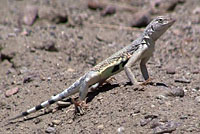 |
|
Female zebra-tailed lizards in the
Nevada desert. |
A male zebra-tailed lizard in the
Nevada desert. |
|
| Description |
| |
| Size |
2.5 - 4 inches from snout to vent (6 - 10 cm), up to almost 9 inches including tail.
|
| Appearance |
A pale thin lizard with very long legs and a long flat tail with black crossbars.
Scales are granular.
|
| Color and Pattern |
Gray or light brown above with light spots and paired dark blotches, which are more distinct on females.
As with many lizards, the coloring is darker during lower temperatures, and lighter with very high temperatures.
Dark crossbars or bands on the tail become very distinct black and white underneath.
This black and white zebra-like pattern gives this lizard its name.
There is pale yellow and orange coloring on the sides.
|
| Male / Female Differences |
Males have two dark bars and develop a patch of blue-green coloring on the sides of the mid belly, which is visible when viewed from the side, during the breeding season.
Dark belly markings are faint or absent on females.
|
| Life History and Behavior |
Activity |
Diurnal.
Tolerant of high temperatures.
Often seen basking on rocks, even on extremely hot afternoons.
A countersunk lower jaw makes it easier for this lizard to burrow into loose or sandy soil to rest. |
| Defense |
Capable of running very fast (possibly the fastest lizard in the desert) facilitated by long legs and streamlined body.
After speeding away, this lizard sometimes stops far ahead in the open, but it will also run to the far side of a bush, out of view, or into a bush or burrow for protection.
Before running, a lizard may curl the tail up towards the back, exposing the black and white bars, and wag it nervously, then continue this behavior while running and after stopping.
This tail display tactic concentrates a predator's attention on the tail, which, if attacked and broken off, can grow back.
More information about tail loss and regeneration. |
| Diet and Feeding |
| Small invertebrates such as insects and spiders, small lizards, occasional plant material. |
| Reproduction |
Mates in Spring, lays eggs June - August.
|
| Habitat |
Open sandy desert washes, desert pavement, and hard pan, with scant widely-spaced vegetation and open areas. Sometimes found in wind-blown sand dunes near hard-packed ground.
|
| Geographical Range |
This subspecies occurs in Nevada not far from the California border north of Honey Lake, where it might occur in washes along the border near Smoke Creek.
C. draconoides ranges throughout the Mojave and Colorado Deserts up to the desert slopes of the Peninsular and Transverse Mountains, and from the Owens Valley north along the eastern edge of the Sierra Nevada Mountains. Found on the coastal slopes of the mountains at San Jacinto Wash and Cajon Wash. Ranges outside California north into northern Nevada, east into extreme southwest Utah, south through Arizona and extreme southwest New Mexico, to Baja California and the west coast of Mexico.
|
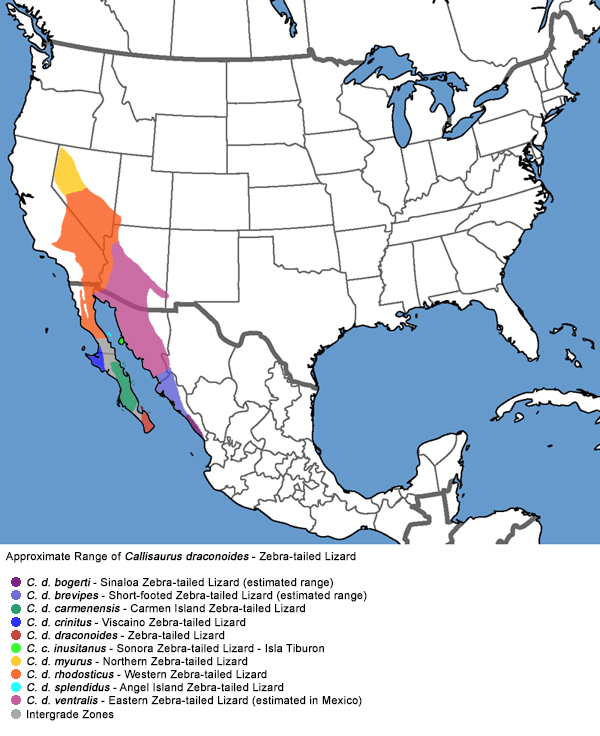
|
| Notes on Taxonomy |
Some experts do not recognize any subspecies of Callisaurus draconoides.
Others recognize three subspecies occurring in the United States:
C. d. rhodostictus, Western Zebra-tailed Lizard
C. d. myurus - Northern Zebra-tailed Lizard
C. d. ventralis - Eastern (or Arizona) Zebra-tailed Lizard
Some experts classify this lizard as Callisaurus draconoides draconoides - Common Zebra-tailed Lizard.
Alternate and Previous Names (Synonyms)
Callisaurus draconoides draconoides - Common Zebra-tailed Lizard
(Stebbins 1985, 2003)
Callisaurus draconoides - Zebra-tailed Lizard (Stebbins 1966)
Callisaurus draconoides myurus - Gridiron-tailed Lizard (Smith 1946)
|
| Conservation Issues (Conservation Status) |
| None |
|
|
Taxonomy |
| Family |
Phrynosomatidae |
Zebra-tailed, Earless, Fringe-toed, Spiny, Tree, Side-blotched, and Horned Lizards |
Fitzinger, 1843 |
| Genus |
Callisaurus |
Zebra-tailed Lizards |
Blainville, 1835 |
| Species |
draconoides |
Zebra-tailed Lizard |
Blainville, 1835 |
Subspecies
|
myurus |
Northern Zebra-tailed Lizard |
Richardson, 1915 |
|
Original Description |
Callisaurus draconoides - Blainville, 1835 - Nouv. Ann. Mus. Hist. Nat. Paris, Vol. 4, p. 286, pl. 24, fig. 2
Callisaurus draconoides myurus - Richardson, 1915 - Proc. U.S. Natl. Mus., Vol. 48, p. 408
from Original Description Citations for the Reptiles and Amphibians of North America © Ellin Beltz
|
|
Meaning of the Scientific Name |
Callisaurus - Greek - kalos = beautiful + saurus = lizard - "we have given the name Callisaurus to indicate the extreme beauty of this little animal."
draconoides - Greek - draco = dragon + -eidos = similarity to a - the species of true dragons
myurus - Greek = mouse tail - possibly referring to the ratio length of body to tail.
from Scientific and Common Names of the Reptiles and Amphibians of North America - Explained © Ellin Beltz
|
|
Related or Similar California Lizards |
C. d. rhodostictus - Western Zebra-tailed Lizard
|
|
More Information and References |
California Department of Fish and Wildlife
Hansen, Robert W. and Shedd, Jackson D. California Amphibians and Reptiles. (Princeton Field Guides.) Princeton University Press, 2025.
Stebbins, Robert C., and McGinnis, Samuel M. Field Guide to Amphibians and Reptiles of California: Revised Edition (California Natural History Guides) University of California Press, 2012.
Stebbins, Robert C. California Amphibians and Reptiles. The University of California Press, 1972.
Flaxington, William C. Amphibians and Reptiles of California: Field Observations, Distribution, and Natural History. Fieldnotes Press, Anaheim, California, 2021.
Nicholson, K. E. (ed.). 2025. Scientific and Standard English Names of Amphibians and Reptiles of North America North of Mexico, with Comments Regarding Confidence in Our Understanding. Ninth Edition. Society for the Study of Amphibians and Reptiles. [SSAR] 87pp.
Samuel M. McGinnis and Robert C. Stebbins. Peterson Field Guide to Western Reptiles & Amphibians. 4th Edition. Houghton Mifflin Harcourt Publishing Company, 2018.
Stebbins, Robert C. A Field Guide to Western Reptiles and Amphibians. 3rd Edition. Houghton Mifflin Company, 2003.
Behler, John L., and F. Wayne King. The Audubon Society Field Guide to North American Reptiles and Amphibians. Alfred A. Knopf, 1992.
Robert Powell, Roger Conant, and Joseph T. Collins. Peterson Field Guide to Reptiles and Amphibians of Eastern and Central North America. Fourth Edition. Houghton Mifflin Harcourt, 2016.
Powell, Robert., Joseph T. Collins, and Errol D. Hooper Jr. A Key to Amphibians and Reptiles of the Continental United States and Canada. The University Press of Kansas, 1998.
Bartlett, R. D. & Patricia P. Bartlett. Guide and Reference to the Turtles and Lizards of Western North America (North of Mexico) and Hawaii. University Press of Florida, 2009.
Jones, Lawrence, Rob Lovich, editors. Lizards of the American Southwest: A Photographic Field Guide. Rio Nuevo Publishers, 2009.
Smith, Hobart M. Handbook of Lizards, Lizards of the United States and of Canada. Cornell University Press, 1946.
Taylor, Emily. California Lizards and How to Find Them. Heyday, Berkeley, California. 2025.Brown et. al. Reptiles of Washington and Oregon. Seattle Audubon Society,1995.
Nussbaum, R. A., E. D. Brodie Jr., and R. M. Storm. Amphibians and Reptiles of the Pacific Northwest. Moscow,
Idaho: University Press of Idaho, 1983.
St. John, Alan D. Reptiles of the Northwest: Alaska to California; Rockies to the Coast. 2nd Edition - Revised & Updated. Lone Pine Publishing, 2021.
|
|
|
The following conservation status listings for this animal are taken from the July 2025 State of California Special Animals List and the July 2025 Federally Listed Endangered and Threatened Animals of California list (unless indicated otherwise below.) Both lists are produced by multiple agencies every year, and sometimes more than once per year, so the conservation status listing information found below might not be from the most recent lists, but they don't change a great deal from year to year.. To make sure you are seeing the most recent listings, go to this California Department of Fish and Wildlife web page where you can search for and download both lists:
https://www.wildlife.ca.gov/Data/CNDDB/Plants-and-Animals.
A detailed explanation of the meaning of the status listing symbols can be found at the beginning of the two lists. For quick reference, I have included them on my Special Status Information page.
If no status is listed here, the animal is not included on either list. This most likely indicates that there are no serious conservation concerns for the animal. To find out more about an animal's status you can also go to the NatureServe and IUCN websites to check their rankings.
Check the current California Department of Fish and Wildlife sport fishing regulations to find out if this animal can be legally pursued and handled or collected with possession of a current fishing license. You can also look at the summary of the sport fishing regulations as they apply only to reptiles and amphibians that has been made for this website.
This animal is not included on the Special Animals List, which indicates that there are no significant conservation concerns for it in California.
|
| Organization |
Status Listing |
Notes |
| NatureServe Global Ranking |
|
|
| NatureServe State Ranking |
|
|
| U.S. Endangered Species Act (ESA) |
None |
|
| California Endangered Species Act (CESA) |
None |
|
| California Department of Fish and Wildlife |
None |
|
| Bureau of Land Management |
None |
|
| USDA Forest Service |
None |
|
| IUCN |
|
|
|
|
